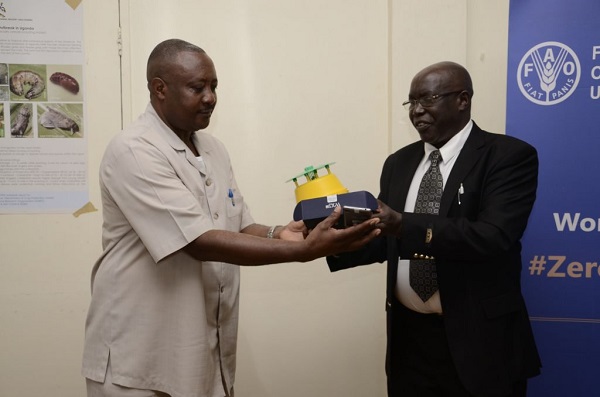As Uganda makes major steps in tackling the risk posed by the ravenous Fall Army-Worm (FAW), a team from the Ministry of Agriculture and the Food and Agricultural Organisation (FAO) have developed a mobile application that will help farmers to fight the pest.
The FAO together with Ministry of Agriculture on Monday launched the application that will enable farmers, agricultural workers, and other partners at the frontline of the fight against FAW in various communities of Uganda.
The application will also help farmers to identify, report the level of infestation, and map the spread of this destructive insect, as well as to describe its natural enemies and the measures that are most effective in managing it.
Dubbed, FAMEWS, or Fall Armyworm Monitoring and Early Warning System, the app is being seen as a lasting solution to the army-worm that has affected farmers in different regions in the country, posing a significant threat to food security.
FAO’s senior agricultural officer, Mr. Keith Cressman, while unveiling the technology to farmers at Mukono Zonal Agricultural Research and Development Institute (MuZARDI) said the new tool will help farmers recognize the new enemy and take immediate measures to stop it.
“With the new application, farmers can hold the phone next to an infested plant, and they will be able to detect and immediately confirm the Fall Army-worm,” said Mr. Cressman.
Must read: List of co-working spaces in Kampala
FAO also handed over equipment to farmers that included 126 mobile phones loaded with the FAMEWS app which will be used in 15 districts to pilot a community-based FAW monitoring and early warning system.
The districts to benefit from the initiate are Mukono, Iganga, Bulamburi, Nakapiripirit, Oyam and Adjumani. Others are Kiryandong, Kibaale, Kasese, Lira, Kayunga, Soroti, Busia, Masindi and Luwero.
Mr. Stephen Byantwale, the Commissioner for Crop Protection at Ministry of Agriculture who received the equipment on behalf of Government urged farmers to start scouting as they prepare to plant maize for the onset second season adding that the move is aimed at minimizing the use of pesticides in the management of FAW.
“We are grateful to FAO for these items that we will be deploying in communities as a pilot project and based on the results, the government will explore opportunities to roll out this approach to other districts given that the data available so far indicates presence of FAW in all districts in Uganda,” said Mr Byantware.
He stated that Uganda has a national strategy and action plan for control of FAW which has short, medium and long-term measures and commended FAO for supporting Uganda to implement national its FAW control and management strategy through the technical cooperation project and sub-regional project on FAW.
The new technology comes at the time farmers are planning and preparing their gardens for the second planting season expected to start by the end of August 2018.
Initially implemented in Madagascar and Zambia, the app is now being rolled out across all countries in Sub-Saharan Africa affected by the invasive pest through the FAO-supported Farmer Field Schools (FFSs) as well as other community-based forums leading the fight against FAW.
The app is an integral part of FAO’s sustainable management programme for FAW in Africa. It supports all stages of Army-worm management from early warning and monitoring to response and risk assessment.
Facts about the app
The app provides valuable insights on how the insect changes over time and space to improve knowledge of its behavior in Africa – in a new context – and guide the best response.
According to the FAO website, the primary target user is the farmer, supplemented by community focal persons, extension agents, and plant protection officers when the farmer does not have a smartphone.
The app is to be used every time fields are checked (scouting) and pheromone traps are counted for Fall Armyworm.
The app is multilingual – initially English and French with three sections: General information, Field scouting, and Pheromone traps.
Data can be transmitted immediately or stored and sent once a connection becomes available. Data from the app provides farmers, communities and countries with early warning and advice on changes in FAW population levels and distribution in order to protect their crops.
The app allows users to monitor FAW, AAW and Stem Borer. The app is very intuitive and easy to use – it should take about 10 minutes to learn.
FAMEWS was inspired by AWorldBridge students and developed by FAO IT-Solutions based on their ideas and inputs from affected countries and other partners.
Download the app here.
More on agritechs:
New harvesting technology excites rice farmers
New app to reshape rice farming in Africa

